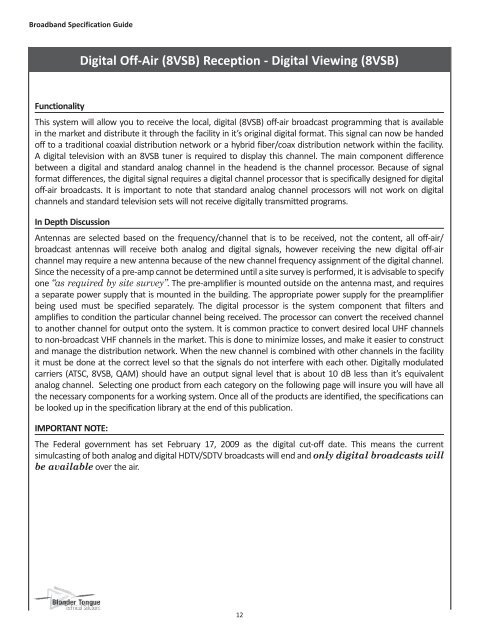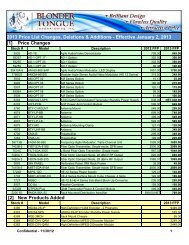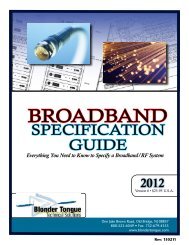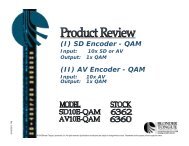Functional Block Diagram - Blonder Tongue Laboratories Inc.
Functional Block Diagram - Blonder Tongue Laboratories Inc.
Functional Block Diagram - Blonder Tongue Laboratories Inc.
You also want an ePaper? Increase the reach of your titles
YUMPU automatically turns print PDFs into web optimized ePapers that Google loves.
Broadband Specification Guide<br />
Digital Off-Air (8VSB) Reception - Digital Viewing (8VSB)<br />
<strong>Functional</strong>ity<br />
This system will allow you to receive the local, digital (8VSB) off-air broadcast programming that is available<br />
in the market and distribute it through the facility in it’s original digital format. This signal can now be handed<br />
off to a traditional coaxial distribution network or a hybrid fiber/coax distribution network within the facility.<br />
A digital television with an 8VSB tuner is required to display this channel. The main component difference<br />
between a digital and standard analog channel in the headend is the channel processor. Because of signal<br />
format differences, the digital signal requires a digital channel processor that is specifically designed for digital<br />
off-air broadcasts. It is important to note that standard analog channel processors will not work on digital<br />
channels and standard television sets will not receive digitally transmitted programs.<br />
In Depth Discussion<br />
Antennas are selected based on the frequency/channel that is to be received, not the content, all off-air/<br />
broadcast antennas will receive both analog and digital signals, however receiving the new digital off-air<br />
channel may require a new antenna because of the new channel frequency assignment of the digital channel.<br />
Since the necessity of a pre-amp cannot be determined until a site survey is performed, it is advisable to specify<br />
one “as required by site survey”. The pre-amplifier is mounted outside on the antenna mast, and requires<br />
a separate power supply that is mounted in the building. The appropriate power supply for the preamplifier<br />
being used must be specified separately. The digital processor is the system component that filters and<br />
amplifies to condition the particular channel being received. The processor can convert the received channel<br />
to another channel for output onto the system. It is common practice to convert desired local UHF channels<br />
to non-broadcast VHF channels in the market. This is done to minimize losses, and make it easier to construct<br />
and manage the distribution network. When the new channel is combined with other channels in the facility<br />
it must be done at the correct level so that the signals do not interfere with each other. Digitally modulated<br />
carriers (ATSC, 8VSB, QAM) should have an output signal level that is about 10 dB less than it’s equivalent<br />
analog channel. Selecting one product from each category on the following page will insure you will have all<br />
the necessary components for a working system. Once all of the products are identified, the specifications can<br />
be looked up in the specification library at the end of this publication.<br />
IMPORTANT NOTE:<br />
The Federal government has set February 17, 2009 as the digital cut-off date. This means the current<br />
simulcasting of both analog and digital HDTV/SDTV broadcasts will end and only digital broadcasts will<br />
be available over the air.<br />
12
















